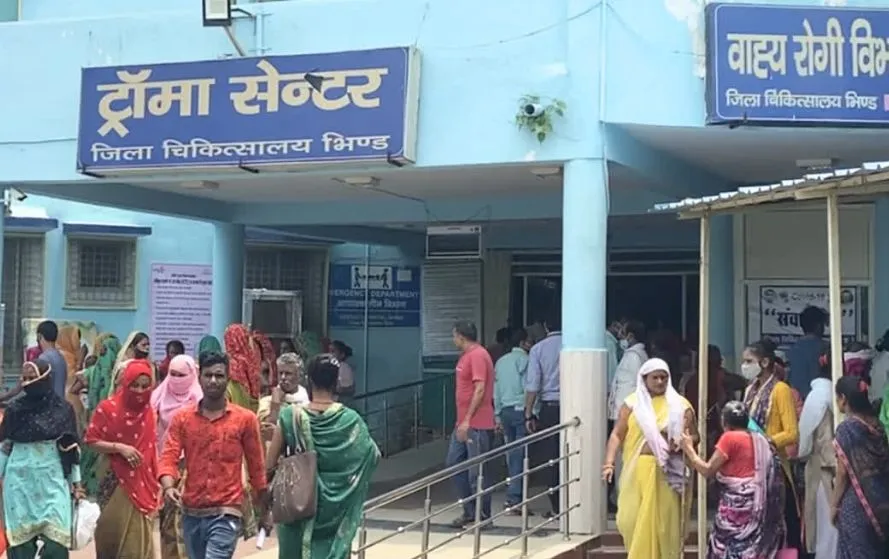Madhya Pradesh: TRAGIC Betrayal of Public Trust in Healthcare!

Madhya Pradesh’s Healthcare Hell: Where Patients Suffer, and Doctors are Helpless.
In Madhya Pradesh, where stretchers are scarce and patience is wearing thin, patients are often forced to rely on makeshift solutions – or their own two feet – to get the cure they need.
A recent incident at the Bhind district hospital in Madhya Pradesh highlights the lack of adequate patient care facilities. A woman carried her husband, who suffered a leg fracture, on her back for 50 meters due to the unavailability of a stretcher.
The incident sparked outrage, prompting an investigation and calls for improvement in patient care infrastructure.
The incident exposes the dismal state of healthcare infrastructure in Bhind district hospital, where patients are forced to suffer due to the unavailability of basic facilities like stretchers.
The woman’s desperate act of carrying her injured husband on her back highlights the helpless situation faced by patients and their families in the hospital.
That act of carrying her injured husband on her back is a heart-wrenching testament to the helplessness of patients and their families in the face of inadequate healthcare infrastructure.
The incident exposes the vulnerability of people who are forced to rely on an ill-equipped system to provide even basic care. The lack of stretchers and other essential facilities in the hospital leaves patients and their families feeling helpless and abandoned.
The woman’s actions demonstrate the desperation and despair that comes with being unable to access proper medical care, leaving her no choice but to take matters into her own hands. The incident highlights the powerlessness of people in rural India, who are often at the mercy of underfunded and understaffed healthcare systems.
The fact that the woman had to carry her husband on her back, even after managing to get him to the hospital, underscores the lack of support and care available to patients and their families.

The helplessness of the people in this situation is a stark reminder of the need for improved healthcare infrastructure and services, particularly in rural areas.
The fact that the Civil Surgeon-in-charge declined to comment on the incident suggests a lack of accountability and transparency in the hospital administration.
The notice issued to the Assistant Manager to explain the stretcher unavailability indicates a clear failure in resource management and planning.
Lack of accountability: By not commenting, the Civil Surgeon-in-charge avoids taking responsibility for the incident, indicating a lack of accountability within the hospital administration.
Transparency deficit: The silence of the Civil Surgeon-in-charge suggests a lack of transparency in the hospital’s functioning, making it difficult for the public to know the truth about the incident.
Cover-up attempt: The refusal to comment may be seen as an attempt to cover up the incident, rather than addressing it and ensuring that such incidents don’t happen in the future.
Disregard for public concern: By not commenting, the Civil Surgeon-in-charge disregards the concerns and outrage of the public, showing a disconnect between the hospital administration and the community it serves.
Inadequate crisis management: The incident and the subsequent refusal to comment demonstrate poor crisis management skills, exacerbating the situation and eroding trust in the hospital administration.
Culture of silence: The Civil Surgeon-in-charge’s silence may indicate a culture of silence within the hospital administration, where issues are swept under the rug rather than addressed and resolved.
Lack of empathy: The refusal to comment shows a lack of empathy for the patients and their families, who are already vulnerable and seeking care.
Overall, the Civil Surgeon-in-charge’s refusal to comment on the incident raises serious questions about the hospital administration’s commitment to accountability, transparency, and patient care.

Similarly, the government’s inaction and silence on the incident perpetuates a culture of impunity, negligence, and disregard for human life, eroding public trust and underscoring a systemic failure to prioritize healthcare and patient well-being.
Inadequate funding: The lack of stretchers and other essential facilities in the hospital may indicate inadequate funding for healthcare infrastructure, a responsibility of the government.
Poor healthcare policy: The incident highlights potential flaws in the government’s healthcare policy, which may prioritize politics over patient care.
Ineffective oversight: The government’s failure to ensure that hospitals are adequately equipped and staffed suggests ineffective oversight and regulation.
Lack of accountability: The government’s silence on the incident and the hospital administration’s lack of accountability may indicate a culture of impunity.
Neglect of rural healthcare: The incident may indicate a broader neglect of rural healthcare infrastructure, a critical aspect of public health.
Insufficient training: The hospital staff’s inability to handle the situation may suggest insufficient training or resources, a government responsibility.
Disconnection from the grassroots: The government’s disconnect from grassroots realities and people’s needs is evident in the lack of adequate healthcare facilities and services.
Prioritization of politics over people: The incident raises questions about the government’s priorities, which seem to favor political interests over people’s lives and well-being.
The government’s response to the incident, including the investigation and any subsequent actions, will be crucial in addressing these concerns and restoring public trust.

The public outcry and social media backlash demonstrate the growing frustration and anger among citizens over the substandard healthcare services in the region. The incident raises questions about the priorities and effectiveness of the hospital administration, which seems more focused on damage control than improving patient care. The lack of adequate facilities and services in Bhind District Hospital is a stark reminder of the healthcare challenges faced by rural India, where access to quality medical care remains a distant dream for many.
This is not the first case that shows the lack of funds in the Public Healthcare Sector.
Underfunding: Public hospitals across India face significant funding gaps, leading to inadequate infrastructure, outdated equipment, and insufficient staff.
Infrastructure woes: Many public hospitals lack basic facilities like clean water, sanitation, and electricity, making it difficult to provide quality care.
Shortage of staff: Public hospitals often have insufficient doctors, nurses, and support staff, leading to overworked employees and compromised patient care.
Outdated equipment: Hospitals often lack modern medical equipment, forcing doctors to rely on outdated technology, which can lead to inaccurate diagnoses and ineffective treatments.
Overcrowding: Public hospitals are often overwhelmed by large patient volumes, resulting in long wait times, unsanitary conditions, and increased risk of hospital-acquired infections.
Lack of specialized care: Many public hospitals lack specialized departments and services, forcing patients to seek care in private hospitals, which can be unaffordable for many.
Rural-urban disparity: Public hospitals in rural areas often face more significant challenges, including a lack of basic infrastructure, staff, and equipment, exacerbating healthcare disparities.
Political apathy: Inadequate funding and neglect of public hospitals are often a result of political apathy and a lack of commitment to prioritizing healthcare.
Corruption and mismanagement: Corruption and mismanagement of funds and resources also contribute to the struggles of public hospitals, diverting resources away from patient care.
These challenges are not unique to Madhya Pradesh but are reflective of the broader struggles faced by public hospitals across India, highlighting the need for systemic reforms and increased investment in healthcare infrastructure.

Increase funding, and allocate more resources to public hospitals, ensuring adequate infrastructure, equipment, and staff.
Improve resource management, ensure efficient use of funds, reduce corruption, and implement transparent accounting practices.
Recruit and retain staff, and offer competitive salaries, benefits, and training opportunities to attract and retain healthcare professionals.
Invest in infrastructure, Upgrade hospitals, provide modern equipment, and ensure clean water, sanitation, and electricity.
Implement healthcare reforms and introduce policies like universal health coverage, health insurance, and public-private partnerships.
Strengthen rural healthcare, establish rural health programs, deploy trained healthcare workers, and provide adequate resources.
Promote public-private partnerships, and collaborate with private hospitals, NGOs, and organizations to supplement resources and expertise.
Enhance patient care, focus on patient-centered care, improve doctor-patient ratios, and ensure access to specialized services.
Leverage technology, and adopt digital healthcare solutions, telemedicine, and electronic health records to enhance efficiency and accessibility.
Foster community engagement and encourage public awareness, education, and participation in healthcare initiatives.
Support research and development, and encourage medical research, innovation, and development of new treatments and technologies.
Improve governance and accountability, strengthen hospital administration, ensure transparency, and hold officials accountable for performance.
Implementing these solutions will require a collaborative effort from the government, healthcare professionals, NGOs, and the public to ensure accessible, affordable, and quality healthcare for all.
In conclusion, the incident at Bhind District Hospital highlights the stark reality of India’s public healthcare system, plagued by inadequate infrastructure, insufficient funding, and a lack of accountability. The struggles of public hospitals in Madhya Pradesh and across the country are a stark reminder of the need for systemic reforms and increased investment in healthcare. The government, healthcare professionals, and civil society must come together to address these challenges and ensure that quality healthcare is accessible to all, regardless of socio-economic status or geographical location. Only through collective effort can we build a healthcare system that truly serves the needs of the people and prevents such incidents from occurring in the future.




